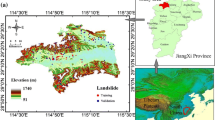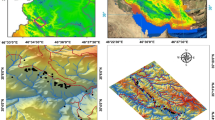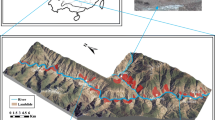Abstract
Statistical landslide susceptibility mapping (LSM) models have been most widely used in literatures. However, limitations and uncertainties remain in these methods. The main goal of the current study was to test and compare the efficiency of a bivariate model (the weight of evidence (WoE)), a multivariate model (logistic regression (LR)) and a machine-learning algorithm (the support vector machine (SVM)) in LSM. Lushan County of China was chosen because of its mountainous terrain and high risky of devastating seismic activities. An inventory of 867 landslides was utilized in this study, 70% of which were used to train these models, and the rest 30% were used to validate their accuracies. Ten factors of aspect, elevation, slope, curvature, peak ground acceleration (PGA), distance to the river (DtoR), lithology, topographic wetness index (TWI), stream power index (SPI) and percentage of tree cover (PTC) were used as input of the landslide susceptibility mapping (LSM) models. Accuracy evaluation based on the areas under the receiver operating characteristic curves (AUC) showed that the LR model gives the highest success rate (78.2%) and prediction rate (76.4%), the SVM has the second-highest success rate (75.9%) and the WoE had the second-highest prediction rate (75.6%). Comparison results suggested that the LR and the SVM are proper models for LSM of the study area. The obtained susceptibility maps would benefit regional land planning and seismic landslide hazard mitigation in the study area.









Similar content being viewed by others
Abbreviations
- LSM:
-
Landslide susceptibility mapping
- LFZ:
-
Longmenshan fault zone
- SDF:
-
Shuangshi-Dachuan fault
- GIS:
-
Geographic information system
- DEM:
-
Digital elevation model
- TWI:
-
Topographic wetness index
- SPI:
-
Stream power index
- PGA:
-
Peak ground acceleration
- PGA:
-
Peak ground acceleration
- PTC:
-
Percentage of tree cover
- WoE:
-
Weight of evidence
- LR:
-
Logistic regression
- SVM:
-
Support vector machine
- ROC:
-
Receiver operating characteristic
- AUC:
-
Areas under ROC curves
- FR:
-
Frequency ratio
- IV:
-
Information value
- RBF:
-
Radial basis function
- CNN:
-
Convolutional neural network
- CAS:
-
Chinese Academy of Science
- LSI:
-
Landslide susceptibility index
- TP:
-
True positive
- TN:
-
True negative
- FP:
-
False positive
- FN:
-
False negative
- FPR:
-
False positive rate
- TPR:
-
True positive rate
- TOL:
-
Tolerances
- VIF:
-
Variance inflation variables
- MLR:
-
Maximum likelihood ratio
- LN:
-
Linear
- PL:
-
Polynomial
- SIG:
-
Sigmoid
References
Arabameri A, Pradhan B, Rezaei K et al (2019a) GIS-based landslide susceptibility mapping using numerical risk factor bivariate model and its ensemble with linear multivariate regression and boosted regression tree algorithms. J Mt Sci 16:595–618. https://doi.org/10.1007/s12665-018-7704-z
Arabameri A, Pradhan B, Rezaei K, Conoscenti C (2019b) Gully erosion susceptibility mapping using GIS-based multi-criteria decision analysis techniques. Catena 180:282–297. https://doi.org/10.1016/j.catena.2019.04.032
Bonham-Carter GF (1994) Geographic information systems for geoscientists. Pergamon Press, Oxford
Chapi K, Singh VP, Shirzadi A, Shahabi H, Bui DT, Pham BT, Khosravi K (2017) A novel hybrid artificial intelligence approach for flood susceptibility assessment. Environ Model Softw 95:229–245. https://doi.org/10.1016/j.envsoft.2017.06.012
Chen Y, Yang Z, Zhang Y et al (2013) From 2008 Wenchuan earthquake to 2013 Lushan earthquake. Sci Sin Terrae 43(6):1064–1072. https://doi.org/10.1007/s11430-013-4642-1
Chen W, Xie X, Peng J, Wang J, Duan Z, Hong H (2017) Gis-based landslide susceptibility modelling: a comparative assessment of Kernel logistic regression, Nave-Bayes tree, and alternating decision tree models. Geomat Nat Haz Risk 8(2):950–973. https://doi.org/10.1080/19475705.2017.1289250
Cortes C, Vapnik V (1995) Support-vector networks. Mach Learn 20(3):273–297
Fan X, Juang CH, Wasowski J, Huang R, Xu Q, Scaringi G, van Westen CJ, Havenith HB (2018) What we have learned from the 2008 Wenchuan Earthquake and its aftermath: a decade of research and challenges. Eng Geol 241:25–32. https://doi.org/10.1016/j.enggeo.2018.05.004
Fanos AM, Pradhan B, Alamri A, Lee CW (2020) Machine learning-based and 3D kinematic models for rockfall hazard assessment using LiDAR data and GIS. Remote Sens 12(11):1755. https://doi.org/10.3390/rs12111755
Hong H, Tsangaratos P, Ilia I, Liu J, Zhu AX, Chen W (2018) Application of fuzzy weight of evidence and data mining techniques in construction of flood susceptibility map of Poyang County, China. Sci Total Environ 625:575–588. https://doi.org/10.1016/j.scitotenv.2017.12.256
Huang Y, Zhao L (2018) Review on landslide susceptibility mapping using support vector machines. Catena 165:520–529. https://doi.org/10.1016/j.catena.2018.03.003
Işık Y (2010) Comparison of landslide susceptibility mapping methodologies for Koyulhisar, Turkey: conditional probability, logistic regression, artificial neural networks, and support vector machine. Environ Earth Sci 61(4):821–836
Javdanian H, Pradhan B (2019) Assessment of earthquake-induced slope deformation of earth dams using soft computing techniques. Landslides 16(1):91–103. https://doi.org/10.1007/s10346-018-1078-x
Jena R, Pradhan B, Beydoun G, Alamri AM, Ardiansyah N, Sofyan H (2020) Earthquake hazard and risk assessment using machine learning approaches at Palu, Indonesia. Sci Total Environ 749:141582. https://doi.org/10.1016/j.scitotenv.2020.141582
Kalantar B, Pradhan BT, Naghibi SA, Motevalli A, Mansor S (2017) Assessment of the effects of training data selection on the landslide susceptibility mapping: a comparison between support vector machine (svm), logistic regression (lr) and artificial neural networks (ann). Geomat Nat Haz Risk 9:1–21
Kavzoglu T, Kutlug Sahin E, Colkesen I (2015) An assessment of multivariate and bivariate approaches in landslide susceptibility mapping: a case study of Duzkoy district. Nat Hazards 76(1):471–496. https://doi.org/10.1007/s11069-014-1506-8
Khosravi K, Pham BT, Chapi K, Shirzadi A, Shahabi H, Revhaug I, Prakash I, Tien Bui D (2018) A comparative assessment of decision trees algorithms for flash flood susceptibility modeling at Haraz watershed, northern Iran. Sci Total Environ 627:744–755. https://doi.org/10.1016/j.scitotenv.2018.01.266
Kumar AS, Kumar A, Krishnan R et al (2017) Soft computing in remote sensing applications. Proc Nat Acad Sci India Sect A Phys Sci 87(4):503–517. https://doi.org/10.1007/s40010-017-0431-0
Lee S (2019) Current and future status of GIS-based landslide susceptibility mapping: a literature review. Korean J Remote Sens 35(1):179–193. https://doi.org/10.7780/kjrs.2019.35.1.12
Nhu VH, Shirzadi A, Shahabi H, Singh SK, Al-Ansari N, Clague JJ et al (2020) Shallow landslide susceptibility mapping: a comparison between logistic model tree, logistic regression, Nave Bayes tree, artificial neural network, and support vector machine algorithms. Int J Environ Res Public Health 17(8):2749
Pedregosa F, Varoquaux G, Gramfort A et al (2011) Scikit-learn: machine learning in python. J Mach Learn Res 12:2825–2830. https://doi.org/10.1524/auto.2011.0951
Pham BT, Pradhan B, Bui DT et al (2016) A comparative study of different machine learning methods for landslide susceptibility assessment: A case study of Uttarakhand area (India). Environ Model Softw 84:240–250. https://doi.org/10.1016/j.envsoft.2016.07.005
Pham BT, Prakash I, Khosravi K et al (2018) A comparison of support vector machines and Bayesian algorithms for landslide susceptibility modelling. Geocarto Int 34(13):1385–1407. https://doi.org/10.1080/10106049.2018.1489422
Reichenbach P, Rossi M, Malamud BD, Mihir M, Guzzetti F (2018) A review of statistically-based landslide susceptibility models. Earth Sci Rev 180:60–91. https://doi.org/10.1016/j.earscirev.2018.03.001
Sahana, M, Pham, BT, Shukla, M, Costache, R. D., & Prakash, I. (2020). Rainfall induced landslide susceptibility mapping using novel hybrid soft computing methods based on multi-layer perceptron neural network classifier. Geocarto International (3).
Schicker R, Moon V (2012) Comparison of bivariate and multivariate statistical approaches in landslide susceptibility mapping at a regional scale. Geomorphology 161:40–57. https://doi.org/10.1016/j.geomorph.2012.03.036
Shahabi H, Ahmad BB, Khezri S (2013) Evaluation and comparison of bivariate and multivariate statistical methods for landslide susceptibility mapping (case study: Zab basin). Arab J Geosci 6:3885–3907. https://doi.org/10.1007/s12517-012-0650-2
Shrestha S, Kang T-S, Suwal MK (2017) An Ensemble Model for Co-seismic landslide susceptibility using GIS and random forest method. ISPRS Int J Geoinf 6(11):365. https://doi.org/10.3390/ijgi6110365
Sorensen R, Zinko U, Seibert J (2006) On the calculation of the topographic wetness index: evaluation of different methods based on field observations. Hydrol Earth Syst Sci 10:101–112. https://doi.org/10.5194/hess-10-101-2006
Sujatha ER, Rajamanickam GV (2015) Landslide hazard and risk mapping using the weighted linear combination model applied to the Tevankarai stream watershed, Kodaikkanal, India. Hum Ecol Risk Assess 21(6):1445–1461. https://doi.org/10.1080/10807039.2014.920222
Tehrany MS, Pradhan B, Mansor S, Ahmad N (2015) Flood susceptibility assessment using GIS-based support vector machine model with different kernel types. Catena 125:91–101. https://doi.org/10.1016/j.catena.2014.10.017
Wang M, Liu M, Yang S, Shi P (2014) Incorporating triggering and environmental factors in the analysis of earthquake-induced landslide hazards. Int J Disaster Risk Sci 5(2):125–135. https://doi.org/10.1007/s13753-014-0020-7
Yan F, Zhang Q, Ye S, Ren B (2019) A novel hybrid approach for landslide susceptibility mapping integrating analytical hierarchy process and normalized frequency ratio methods with the cloud model. Geomorphology 327(FEB.15):170–187
Yu C, Chen J (2020) Landslide susceptibility mapping using the slope unit for Southeastern Helong City, Jilin Province, China: A Comparison of ANN and SVM. Symmetry 12:1047. https://doi.org/10.3390/sym12061047
Acknowledgements
All financial supports were greatly acknowledged.
Funding
This research was supported by the National Natural Science Foundation of China (51708199); Science and Technology Infrastructure Program of Guizhou Province (2020-4Y047; 2018-133-042); Fundamental Research Funds for the Central Universities (531118010069); Science and Technology Project of Transportation and Communication Ministry of Guizhou Province (2017-143-054); and Science and Technology Program of Beijing (Z181100003918005).
Author information
Authors and Affiliations
Corresponding author
Ethics declarations
Conflict of interest
The authors declare that they have no competing interests.
Additional information
Responsible Editor: Biswajeet Pradhan
Rights and permissions
About this article
Cite this article
Zhou, S., Zhang, Y., Tan, X. et al. A comparative study of the bivariate, multivariate and machine-learning-based statistical models for landslide susceptibility mapping in a seismic-prone region in China. Arab J Geosci 14, 440 (2021). https://doi.org/10.1007/s12517-021-06630-5
Received:
Accepted:
Published:
DOI: https://doi.org/10.1007/s12517-021-06630-5




